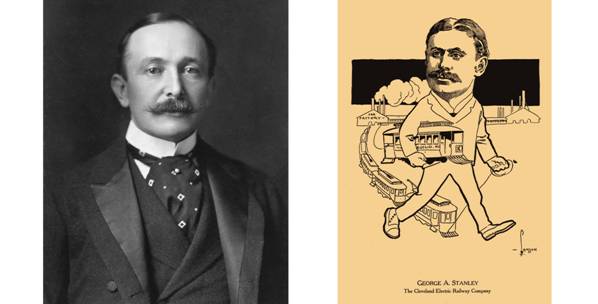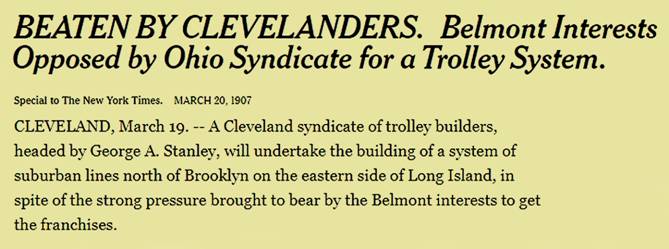Creating the New York and North Shore
Despite what local people may have thought, this was not " Hicksville's Trolley." It was a transit line for western Long Island. Revenue came primarily from towns to the west and from Queens, although Hicksville played a role. Why was it built?
Trolley Mania
Around 1900, a craze for trolleys began. Everywhere, small-town businessmen, developers, and politicians thought a trolley line was the catalyst needed to "put their town on the map." Supposedly, trolleys meant jobs and prosperity; they increased property values and spurred growth. Trolley towns collected more taxes - giving politicians more money to spend in order to make voters happy. Besides, trolley lines gave townspeople something to brag about.

Postcard Fake of Trolley Line from Rowsome, Trolley Car Treasury
This postcard of a town is actually a composite of several photographs, made with paste and scissors, darkroom technique, and some hand-drawn details - rails, but no overhead wires! The town never had trolleys, but people who received the postcard didn't know that.
In reality, many trolley lines failed. A critical mass of fare-paying riders was needed to keep such enterprises going.
Entrepreneurs, Investors
New York City's swelling population pushed commuters towards rural Long Island, catching the eyes of two men - a veritable Goliath, and an aspiring one. Global financier August Belmont Jr. had built the IRT, New York's first subway. His many other enterprises included Belmont Park and a fashionable Manhattan hotel. Beneath the latter was a private underground IRT siding, used only by his personal subway car. When the IRT tunnels were extended under the river to Brooklyn, they reached the LIRR tracks, so that Belmont's private car could take him directly between his hotel and his racetrack.
As trolley companies sprang up on Long Island, he sought control of the best of them.
August Belmont, Jr. - George A. Stanley

Library of Congress photo - Clevelanders "As We See 'Em"
George A. Stanley was from Cleveland, where he had helped his family build a trolley empire. Looking east, the Stanleys had beaten Belmont to the ownership of two profitable lines in southern Nassau. When Belmont could not put the lines out of business, he bought them from the Stanleys, who profited from the sales.
The Stanley family now contemplated northern Nassau, where trolley lines had been proposed, but never built. Working with lawyer James A. MacElhinny of Rosyln, they revised one of the old proposals, submitted the result, and were granted a franchise. They incorporated the NY&NS, with George Stanley as its President.

The Stanleys projected modest but solid revenue, revenue which would grow when trolleys reached Hicksville and triggered a population boom. Ridership would grow with the population, and the eastern branch would make a good profit. Nothing was certain, but most likely, the worst expectation was one of déjà vu: the line would be successful enough until August Belmont Jr. bought it.
Opposition, Obstacles
The LIRR did not want new competitors that carried passengers between towns it already served; furthermore, it enjoyed good relationships with Belmont's companies. It would do all it could to prevent the eastward growth of the NY&NS.
At Mineola, the railroad's tracks to Oyster Bay turned north, continuing on to the Sound. Any trolley line heading east would need to bridge them at some point (among other reasons for using a bridge, trolley wires strung across a railroad would not leave enough clearance for trains to pass underneath). If the LIRR learned where the bridge was to be built, the railroad could buy parcels of land the NY&NS needed for the approaches, effectively blocking construction.
Thus, as the NY&NS built the new Hicksville branch, it slowly (and quietly) acquired the real estate needed for the bridge. As the new branch's wire and tracks stretched towards Mineola from the east, they were stopped a good distance from the railroad, so as not to make obvious the location at which the trolley line wanted to construct the bridge.
Although there was no connection to the western part of the NY&NS, eventually there was a usable trolley system east of Mineola; all it needed was some trolley cars. The LIRR guessed correctly that the line would hire movers, to bring some of its trolleys from the west for use on the isolated new branch. The movers would have to transport them along one of the public roads that crossed the railroad's tracks near Mineola. Illegally, the railroad hired "watchmen" (in effect, thugs) to prevent any trolley's being brought east. Nevertheless, one January morning, a trolley stood on the new trolley line. A day later, a second one had joined it. The watchmen, obviously bribed, denied knowing how the trolleys got there.
Thus, on Saturday, January 23, 1909, Hicksville finally got its trolleys. With no trolley bridge to the west, its residents could ride only as far as Mineola. To go further, they had to walk across the railroad tracks, and board the other part of the NY&NS.
Celebration

collection of Mark Thomas, HHS Class of 1975; used with permission
Long Island rail historian Vincent F. Seyfried believed that this winter's day scene shows NY&NS No. 8, festooned with bunting for the occasion, after it made the first trolley arrival at Hicksville.
The NY&NS had worked hard to introduce the new trolley service before the end of 1908. As late December neared, further legal challenges against it were filed by the LIRR, postponing the planned opening of the line. Even so, on New Year's Eve trolley company employees held a long-planned "trolley ball" for townspeople at the Grand Central Hotel.
Anticipation grew in the following weeks, and when the day arrived, a crowd gathered early at the terminus. At 1:30 PM, as the trolley approached, the echoing boom of the town's cannon signaled the arrival. A marching band led a parade of officials and happy townsfolk to "the old country road" - and then right back to the Grand Central for a two-hour ceremony, during which children were given free trolley rides to Westbury and back.

On January 29, 1909, the Huntington Long Islander reporter partook of a little trolley mania, describing the new trolley line with some hyperbole. Noting the railroad's last-ditch legal attempt to block it, he wrote as if the railroad had never deigned to carry passengers between Hicksville and New York City. He also proclaimed that Hicksville had gone from "isolation" to "importance," and that the "little village on the plains" would soon double its population because of the new service.
Of course, the Hicksville-beat reporter may have been deliberately teasing the people in the newspaper's head office - Huntington's own trolley link with Amityville would not be completed for some months.

